Bulletin – September 2015 Payments Banknote Stakeholder Engagement
- Download the article 201KB
Abstract
The Reserve Bank has a responsibility to ensure confidence in Australia's banknotes as a secure method of payment and a store of wealth. One of the ways in which the Bank does this is by providing education and training to people who handle cash regularly in their jobs, and the public in general, so that they can easily check the authenticity of their banknotes. In the lead-up to the next generation of Australian banknotes, this work will be crucial to ensure public confidence in the new banknote series. It is also important to engage with key stakeholders who produce and use machines that will accept the new banknotes. This article outlines the work that the Bank has undertaken to establish suitable communication channels and engage with key stakeholders in preparation for the Next Generation Banknote (NGB) program.
Transcript
The Reserve Bank has a responsibility to maintain the public's confidence in Australia's banknotes. That confidence can take two forms. Security, making sure that the banknote you have is genuine. And functionality, you want to know that when you take your banknote out to conduct a transaction that it's going to be accepted.
Increasingly, we're using machines in our transactions. They can be ATMs, they can be self-service checkouts and they can be vending machines. Twenty years ago when we released the current series of banknotes, machines weren't about. Acceptance was more about whether the teller or the cashier would accept your banknotes. Now, we've got to make sure that these machines accept banknotes and dispense banknotes properly for the economy to keep functioning properly.
The Bank regularly talks to many stakeholders and as we prepare for the new series we've increased that engagement with all of those stakeholders. Banknote machine manufacturers were identified as being an important stakeholder group that we needed to increase our engagement with.
We'll provide them with real banknotes so they can make those final adjustments to their machines and distribute them around the country so they'll be ready to accept the new banknotes when we release them.
Introduction
Banknotes continue to be an important method of payment and store of wealth for Australians. Despite the increased use of electronic payment options, the value of banknotes in circulation has consistently grown by 5 per cent each year over the past 12 years (Graph 1). In addition, surveys show that cash accounts for almost half of all transactions and continues to be the most frequently used payment method for day-to-day transactions, particularly those of low value (Meredith, Kenney and Hatzvi 2014) (Graph 2). This suggests that banknotes are likely to remain an important part of the payments landscape for the foreseeable future.
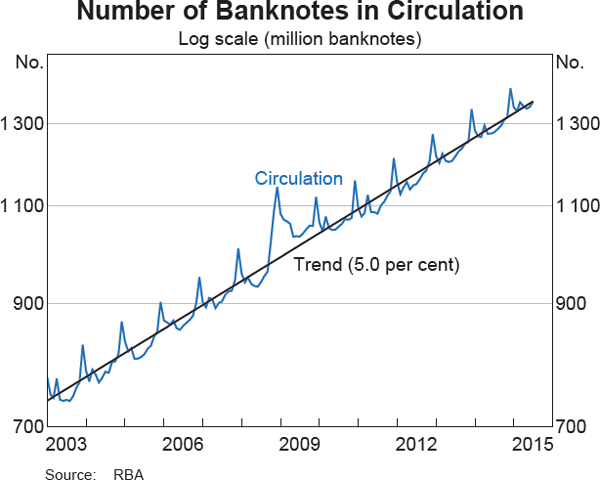
To ensure the public remains confident in banknotes as a means of payment and store of wealth, the Reserve Bank works to develop and issue banknotes with security features that are easy to use and difficult to copy. Public engagement plays a crucial role in the effectiveness of the security features, including by helping the public and cash-handling businesses to recognise genuine banknotes. This is particularly the case for the NGB program, which is focused on upgrading the security features on Australian banknotes (Kim and Turton 2014). Further, effective engagement will promote acceptance of the new banknote series by the public and understanding that both series of banknotes are able to be used in transactions, and allow machines – such as automated teller machines (ATMs), self-service checkouts and vending machines – to accommodate the new banknotes.
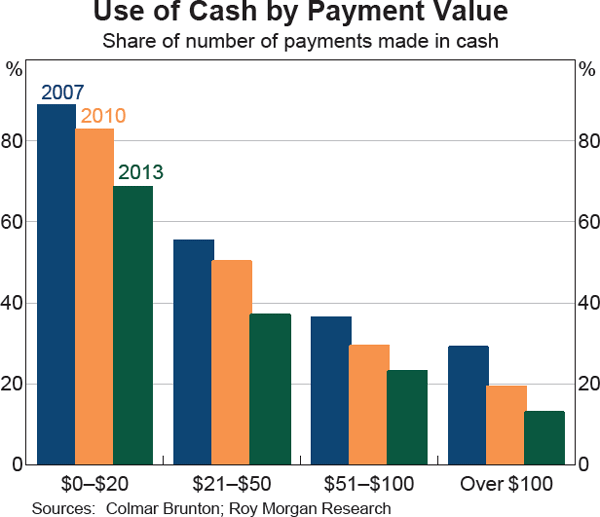
This article discusses the initiatives implemented in recent years to engage with a wide range of stakeholders including banknote equipment manufacturers, retail organisations, financial institutions, schools and the vision-impaired community.
Channels of Engagement
For several years the Reserve Bank has been enhancing a number of elements of its key means of communication regarding banknotes. In part, this has been done in anticipation of the new banknote series. The aim of this program is to establish communication channels that the public are aware of and trust to obtain information on banknotes.
Public engagement
The Bank receives around 1,500 banknote-related enquiries annually. These cover a range of topics including how to handle damaged banknotes, how to purchase numismatic products, the rules governing the reproduction of banknote images, the legal tender status of banknotes, and details of the number of banknotes produced and in circulation. A considerable number of questions also relate to how to identify a counterfeit and what to do if one is received.
In addition to fielding public enquiries, presentations are given to various stakeholder groups, including primary and high school students, English as a Second Language groups and other special interest groups. Many of these are given in the Bank's Museum of Australian Currency Notes, located in its Head Office in Sydney. These presentations provide a valuable opportunity to share information about the security features and production process of Australia's banknotes, and for Bank staff to answer questions directly from the public. As well as assisting the public with their enquiries, this very direct engagement provides insights into the level of community awareness about banknotes and helps the Bank improve its communication.
The Museum is also open to the public on Australia Day each year. In 2015, there were more than 1,900 visitors on that day, with attendees a mix of family groups, as well as local and international visitors. Visitors to a dedicated banknote section in the Museum were provided with educational materials, shown videos and guided through interactive activities on the banknotes website (banknotes.rba.gov.au).
Online resources
The banknotes website was launched in August 2012. The purpose of this website is to improve the public's awareness of the design and security features of Australia's banknotes in an informative and engaging manner that is readily accessible to all Australians. The website includes short videos and information about the design, production and distribution of Australian banknotes, along with counterfeit detection. In addition to factual information for a general audience, it includes interactive activities and games aimed at younger audiences.
Website activity is largely driven by referrals from news articles, and recently there has been a tendency for social media posts (such as Facebook, Twitter and online discussion boards) to refer to the website to clarify banknote-related information. In 2013, the website was named ‘Best New Currency Website’ at the Excellence in Currency Awards established by the International Association of Currency Affairs.
In recognition of the influence of social media, the Bank also uses YouTube to share banknote-related videos with a wider audience and has been increasingly using Twitter as a way to direct people to relevant sources of information.
The Bank has also developed online communication tools to assist stakeholder groups with their specific needs:
- An education resource aimed at teaching primary school students about Australia's banknotes was launched in January 2015 (see ‘Box A: Engagement with Younger Audiences’).
- A law enforcement portal, developed in consultation with law enforcement agencies, was launched in November 2012 to make information about the identification, handling and administration of counterfeit banknotes more readily accessible to police officers.
- A machine-readiness portal was developed in 2014 to provide information to assist manufacturers, distributors and users of banknote processing equipment in the lead-up to the issuance of the new banknote series.
Stakeholder outreach
In recent years, the Bank has established an outreach program designed to identify and utilise opportunities to work with stakeholders to educate their staff, customers and clients about the existing banknotes and their security features. Through the program, the Bank engages with organisations and representative bodies across a range of sectors such as retail, banking and hospitality (fast food, gaming and clubs), as well as groups that represent older generations and people from culturally and linguistically diverse backgrounds.
In addition to serving an educational purpose, this program has provided an opportunity to build relationships with key stakeholders and better understand how to meet their education and training needs. This engagement has also enabled the Bank to establish itself as a primary resource for future enquiries.
An important dimension of this outreach program is the provision of information and training directly to stakeholders both as needed and as new information becomes available. In this respect, the Bank has been increasing its liaison with businesses that handle cash and community groups, with more than 40 presentations relating to the forthcoming new banknote series delivered since 2012. These included 32 presentations to equipment manufacturers and users, and 10 to the vision-impaired community. This engagement also provides important intelligence to the Bank to ensure the continued efficacy of its communication material.
Over the past few years, the Bank has also held a number of workshops on counterfeit deterrence with representatives from state and federal police, commercial banks, retail institutions, casinos and cash-in-transit companies. These workshops were aimed at providing hands-on training and improving working relationships with key stakeholders. They included presentations by Bank staff and the Australian Federal Police. Topics covered were the current counterfeiting situation in Australia, the roles and responsibilities of various stakeholders and counterfeit detection.
Media engagement
The Bank regularly receives enquiries from the media related to banknotes. In response, staff provide background information to journalists, and participate in radio and print interviews. These opportunities are an invaluable channel through which the Bank can reach a wider audience.
Box A: Engagement with Younger Audiences
The Reserve Bank has undertaken a number of initiatives focused on school-age audiences to assist a younger generation to develop an interest in, and familiarity with, Australian currency and to provide them with the knowledge required to identify genuine banknotes. These audiences are also likely to share key messages with their families.
In collaboration with the New South Wales Department of Education and Communities, the Bank developed an online primary school education resource, ‘Learning About Banknotes’ (banknotes. rba.gov.au/primary-education). It is aimed at educating students about Australia's banknotes through interactive games, activities and stories. This resource has been designed to provide information about banknotes through history and mathematics activities, which are aligned to the Australian curriculum. Activities are mapped to syllabus requirements for Year 2 Mathematics and Years 2 and 3 History, and teaching notes are available to guide teachers through the activities and games. The resource incorporates interactive whiteboard activities to enhance the experience for both teachers and students.
The Bank also conducts regular presentations to school groups in its Museum of Australian Currency Notes. There has recently been a greater focus on targeting younger attendees through additional ‘kid-friendly’ activities in the Museum on Australia Day. This has included activities specifically designed for children such as activity sheets, a ‘Chatterbox’ origami game focused on security features, giant puzzles and games from the website.
Surveys and Research
To better understand public attitudes to banknotes and how people perceive banknotes, the Reserve Bank has conducted a number of online surveys and focus group studies. This research has been used to assess the success of the Bank's current education activities and provide feedback to the Bank on potential designs for the new banknote series. Future research will be used to determine the effectiveness of the communication campaign for the new banknote series.
Online surveys
Online surveys conducted in 2010, 2012 and 2014 were aimed at understanding the public's general perceptions of Australia's banknotes, what they know about banknotes, how they check their banknotes for authenticity and how confident they feel about the security of Australia's banknotes. Recently, these surveys have also included questions to assess the level of awareness of the new banknote series.
These surveys indicated a high level of confidence in Australia's current banknotes, with 58 per cent of participants stating that they thought the banknotes were, in general, sufficiently secure against counterfeiting. Furthermore, the perceived likelihood among survey participants that they would receive a counterfeit was low, although 6 per cent thought that they had received a counterfeit at some point.
Reflecting this high level of confidence, the surveys also indicated that there is a degree of complacency among the public about banknote security, with 68 per cent of people rarely or never checking their banknotes carefully to make sure they are genuine. The surveys indicated that 45 per cent of people learnt what they know about banknotes through use and experience, while almost 30 per cent could not recall how they learnt what they know. The majority of respondents (two-thirds) indicated that they would use the internet if they wanted to learn more about Australian banknotes but only one-third knew that the primary source of information was the Bank's website.
The outcomes of this research also revealed that, at the early stage of the next generation banknote program, public awareness of the new banknote series is relatively low, with only 8 per cent of participants in the most recent survey indicating that they had heard of the Bank's program to upgrade the banknotes.
Focus groups
In 2010, group discussions were held with selected members of the public and cash handlers. The objective of this was to investigate the public's knowledge and opinions of Australia's banknotes, their security features and designs, and public awareness and perceptions of counterfeiting. In 2014, a further focus group study was conducted to observe and evaluate the public's reactions to a test note, which included design and security features under consideration for the new banknote series. Notably, most participants agreed that the time was right to increase the security features on our current banknotes and 85 per cent of participants ‘liked’ the test note – not just for the increased security aspects, but also for its overall appearance.
The viewpoints of specific stakeholders on key aspects of banknote design have also been sought. Most notably, the Bank has been working with the vision-impaired community to seek input on accessibility options for the new banknote series. The Bank had confirmed its intention to retain the accessibility characteristics of Australia's banknotes, including different sizes across banknote denominations, bold and contrasting numerals, and vibrant colours. The Bank also engaged with representatives from the vision-impaired community to assess the efficacy of the accessibility features of the current banknotes and their appetite for additional features. Following this consultation, the Bank has since announced that the new banknotes will include a tactile feature to assist with denominating banknotes (Springer, Subramanian and Turton 2015).
Banknote Equipment Manufacturer Engagement
The number of machines in Australia that process banknotes in one form or another is substantial – it is estimated that there are more than 30,000 ATMs, 8,000 self-service checkouts, 200,000 gaming machines and more than 250,000 vending machines in Australia that will need to be upgraded and reconfigured to ensure that they can accept and dispense the new banknotes (Kim and Turton 2014). Most people encounter machines that process banknotes on a regular basis, in situations such as:
- paying for goods and services at self-service checkouts, transport ticketing machines, parking ticket machines, vending machines and gaming machines
- making withdrawals and deposits via ATMs
- using machines to count, authenticate and store banknotes.
For further details see ‘Box B: Banknote Machine Industry’.
The Reserve Bank identified a need to engage closely and regularly with banknote equipment manufacturers (BEMs), machine distributors, and machine deployers and owners in the lead-up to the issuance of the new banknote series to help maintain the ease of use of banknotes as a payment mechanism. In light of the potentially significant upgrades required for machines to process the new banknotes, the Bank launched an engagement program early in the banknote development process, many years before the first new banknotes were due to be issued.
A key objective of this engagement is to achieve a high level of banknote acceptance by machines in the community. At the time of issuance, it will be important for businesses and the public to be able to continue to make payments and withdrawals at machines, and use machines to count, sort and validate banknotes effectively and efficiently. This can be achieved by securing commitment among BEMs, machine distributors, and machine deployers and owners to upgrade the machines as required.
Box B: Banknote Machine Industry
Banking and
financial
Machines that allow for cash withdrawals or deposits with or without the need for a teller.
Examples:
- ATMs (deposit and issue)
- Teller assist units
- Change machines
- Currency conversion products
Goods/services
vending
Single note validators are often in machines used by the public for purchases from unattended payment terminals.
Examples:
- Self-service checkouts
- Transport ticketing machines
- Parking ticket machines
- Car wash machines
- Gaming machines
Counting and authentication
Larger machines are used by high-volume cash handlers such as retailers, banks and cash-in-transit (CIT) companies.
Examples:
- High-speed processors
- Desktop processors
- Banknote counters
Source: RBA
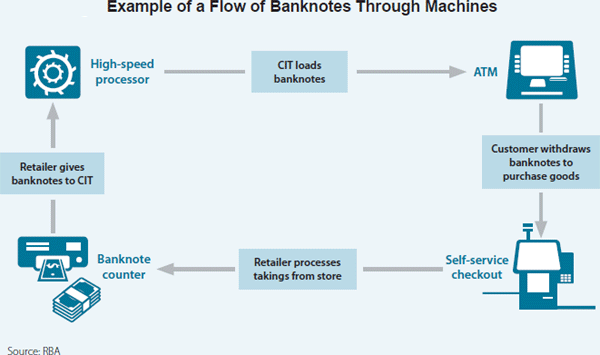
Machine Readiness Program
A number of steps have been taken by the Reserve Bank over the past six years to identify and engage with the banknote machine industry. This initially included preliminary research with a small number of BEMs, and more recently has expanded as part of a formal Machine Readiness Program.
As of September 2015, the Bank has engaged with all companies that it is aware of as active in the Australian market. It is expected that these companies make up the majority of the industry. The outcomes from this engagement have been positive and the Bank is becoming increasingly confident that most machines will be able to process the new banknotes when the first denomination is issued.
Research stage
In 2009, a small number of key BEMs were invited to participate in an initial trial. The purpose of the trial was to test the capabilities of existing equipment to process test notes with features similar to those being planned for the new banknote series. The BEMs participating in the trial represented key manufacturers of ATMs, teller assist units, medium-and high-speed processors, and single note validators. While the BEMs acknowledged that the Bank had made many decisions to minimise the impact of the change on the industry, the feedback also suggested that the industry would be challenged by the new banknotes. As shown in Graph 3, at that time participants had concerns about processing the new banknotes.
In 2011, the Bank invited the same BEMs to participate in a second trial. The test notes provided to BEMs in this second trial addressed some of the issues raised during the earlier engagement. The feedback was more positive than that received in 2009 and some BEMs were becoming increasingly confident that there were solutions to address the processing challenges. The other BEMs, however, still had concerns about the capability of their machines to process the test notes. The differentiating factor between the two groups of BEMs – those that were gaining confidence and those that were not – was related to the manner in which banknotes moved through their machines. The BEMs whose machines processed banknotes short edge first were more confident, while BEMs that still had concerns processed banknotes long edge first.

In response to this feedback, the Bank approached the BEMs again in 2012 with a new feature that could be incorporated into the banknotes to assist machines that processed banknotes long edge first. At this point, an additional three BEMs were invited to participate. Indications of success continued to increase. Overall, with the exception of banknote counters, there was at least one manufacturer in each industry segment the Bank had engaged with that expected to be able to develop a solution to process the new banknotes (Graph 4). This positive feedback gave the Bank confidence to proceed with its chosen banknote features.
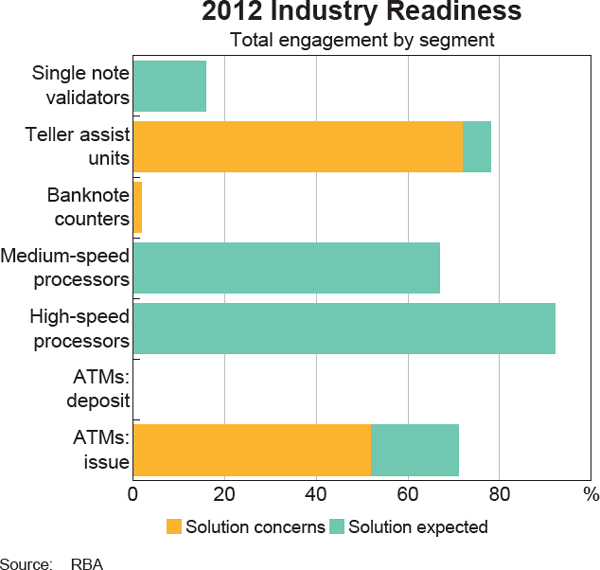
Readiness stage
In order to assist the broader industry to prepare machines for the new banknotes, it was necessary to establish an accurate assessment of the machines in use and the manufacturers that were active in the Australian market. To this end, in late 2012 the Bank surveyed a number of stakeholders – retailers, financial institutions, independent ATM deployers, public transport operators, gaming venues and BEMs – to identify as many organisations as possible that were active in the Australian market.
On the basis of the results of this survey, the Bank expanded its engagement with the BEMs to a wider number of organisations in early 2013. The Bank held a number of information sessions where manufacturers and distributors were notified of the impending new banknote series and provided with details about the planned banknote features and a broad timeline. These sessions were followed up with bilateral discussions and an additional information session in mid 2014 to provide attendees with further detailed technical information about the new banknotes. As of September 2015, the Bank had engaged with 54 BEMs and machine distributors.
In addition to the information sessions, the Bank provided all BEMs and distributors with access to sample notes and banknotes that were close to the final design. Specifically, the Bank adopted a three-phase approach to assist the industry to prepare their machines for the new banknotes:
-
Phase 1 – developing processing capabilities
BEMs and distributors were offered sample notes in October 2014. These sample notes had features similar to those planned for the new banknote series. While they did not have the same design as the final banknotes, they incorporated all of the intended security features. The sample notes were provided so that BEMs could develop their capability to transport the new banknotes through their machines. To date, 30 companies have requested Phase 1 sample notes.
-
Phase 2 – confirming processing capabilities
In December 2014, BEMs and distributors were offered the opportunity to access Phase 2 sample notes, which more closely resembled the final banknote design. This material assisted BEMs and distributors to confirm whether their machines could process the new banknotes. Owing to the greater security surrounding the Phase 2 sample notes, participants were required to conduct testing in either the Bank's Sydney or Craigieburn facilities. On rare occasions where transporting large and expensive machines posed a significant logistical challenge, testing was conducted outside the Bank, with appropriate security arrangements in place. To date, 20 companies have accessed Phase 2 sample notes.
-
Phase 3 – developing authentication models
The final phase of the Machine Readiness Program involves participants using actual banknotes to ensure that their machines can distinguish between genuine banknotes and potential counterfeits. Most machines that accept banknotes undertake a thorough examination of the banknote to determine its authenticity. Banknotes that fail this examination are rejected by the machine. BEMs develop complex algorithms to assist with this process, and they need access to actual banknotes to ensure that these algorithms function accurately. This phase will also provide a final opportunity to test, and, if necessary, refine, the transportation systems within machines. The Bank's objective is to provide actual banknotes to BEMs and distributors at least six months prior to issuing the new banknotes into the community, which the BEMs have indicated will allow sufficient time for them to develop and deploy new authentication models.
Current industry readiness
After six years of engagement with the industry, the current state of machine readiness appears to be positive. A number of BEMs have developed solutions to process the new banknotes (Graph 5). Overall, the Bank expects that all validators and high speed processing machines will be capable of accepting and processing the new banknotes. According to BEMs, the validators utilised in most machines that are used directly by the public (such as ticketing, vending and gaming machines) will be ready for the new banknotes.
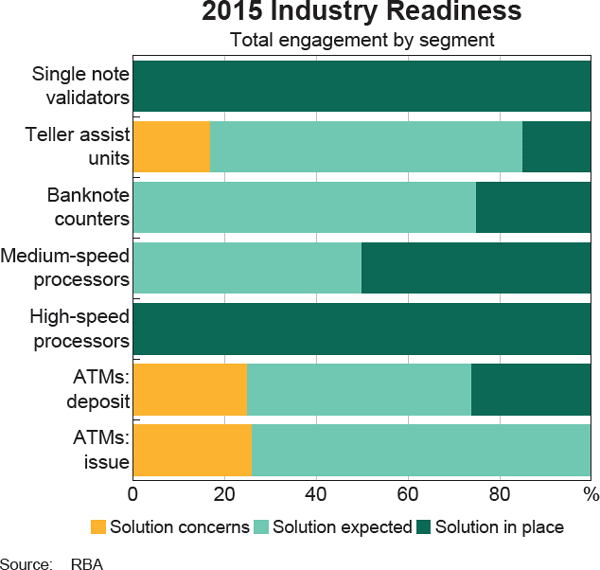
There is still work to be done with some ATMs, teller assist units, banknote counters and medium-speed processors. The BEMs nevertheless indicate that solutions are progressing well and the expectation is that most machines will be ready for the issuance of the first denomination.
Engagement with owners and deployers of machines
While it is important that manufacturers develop effective solutions to process the new banknotes, the final stage in the machine readiness process is to upgrade machines deployed in the community. This is a large logistical challenge shared by machine manufacturers, deployers and owners. The Bank has little influence over the decisions by businesses to upgrade individual machines. But by communicating early and frequently with the deployers and owners of machines about the new banknote series, it can help to create an environment where owners and manufacturers can establish a streamlined approach to upgrading machines. Approaching the industry early has also removed some of the ‘surprise’ element associated with the upgrade.
To date, the Bank has presented to more than 150 stakeholders in the banknote equipment industry, both bilaterally and through representative industry associations, which have also passed information to their members.
Future Activities
Engagement with banknote stakeholders covers a range of communication channels and continues to expand into new areas. In the lead-up to the issuance of the new banknote series, which is scheduled to commence in late 2016, there is expected to be increased engagement with the public and key stakeholders, including BEMs, commercial banks, retailers and special interest groups.
There will be considerable interest in the new banknotes and the rationale behind the change. As part of a public awareness campaign, the Reserve Bank is planning a number of communication activities utilising a combination of media channels to deliver key messages about the new banknotes to the community. This public awareness campaign, along with the supporting engagement activities, will help inform the public about the new banknote series, the security features on the banknotes and where to go for more information.
Providing adequate and effectively targeted information will reduce the risk of confusion among the public and cash-handling businesses about Australia's banknotes and increase their confidence in the ability to recognise and authenticate a genuine banknote. It will also provide an opportunity to explain that both the exisiting series and new series of banknotes will be able to be used in transactions.
Engagement and consultation with stakeholders that the Bank has identified as having specific requirements will also continue. The Bank will continue to engage with the vision-impaired community to provide tailored information about the tactile feature so that users remain confident when using Australia's banknotes. The Bank will also ensure that its websites meet best practice standards for accessibility so all members of the public can obtain information about banknotes.
The Bank will move into Phase 3 of the Machine Readiness Program as the issuance date for the new banknote series draws closer. This engagement represents a crucial step in preparing machines to be ready for when the new banknotes begin circulating. Early engagement with key business sectors will also be required to provide industry with a level of understanding that will assist in driving awareness among other important groups. Ultimately, these activities will help to ensure the public are fully informed of the new banknote series and remain confident in Australia's banknotes as a secure and stable payment method.
Footnote
The authors are from Note Issue Department. [*]
References
Kim E and T Turton (2014), ‘The Next Generation Banknote Project’, RBA Bulletin, March, pp 1–11.
Meredith J, R Kenney and E Hatzvi (2014), ‘Cash Use in Australia’, RBA Bulletin, June, pp 43–54.
Springer K, P Subramanian and T Turton (2015), ‘Australian Banknotes: Assisting People with Vision Impairment’, RBA Bulletin, March, pp 1–12.